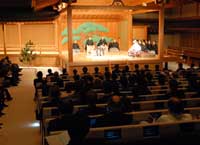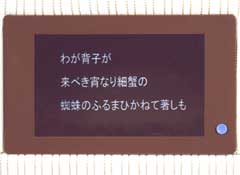|
TRADITION GOES HI-TECH
National Noh Theater Puts LCD Displays in Seats
(January 5, 2007)
|
|
The National Noh Theater in Tokyo's Sendagaya district has become the first such establishment in Japan to introduce a system for displaying both Japanese and English subtitles at each individual seat. The aim is twofold: to make this form of traditional Japanese theater more accessible to a younger audience, given that even many Japanese people these days cannot understand the lines and chants of a Noh play, and to spread Noh internationally, which is recognized by UNESCO as an Intangible Cultural Heritage. Running Commentary The subtitles are displayed on LCD screens located in the back of each seat, like in an airplane. (Seats in the front row have screens to the side.) The user can choose between English or Japanese subtitles, and in addition to the lines being spoken, information on the background of the story and the characters is also provided. For seasoned Noh aficionados, the subtitles can of course be turned off. In order not to distract from the performance, the brightness of the screens was carefully considered, and the subtitles are not visible to people in adjacent seats, who can watch the play without being disturbed. The total cost of replacing all of the seats and the other work needed was just under ¥200 million ($1.74 million at ¥115 to the dollar), and the process took one year to complete. The National Noh Theater, National Theater, and other facilities operated by the Japan Arts Council first introduced subtitles five years ago. In the Kabuki Appreciation Classroom at the National Theater, subtitles are displayed off to the side of the stage. While there were some concerns that the display might distract the audience, the response at the time was favorable, so performances with subtitles were then made a regular feature of the schedule. The National Noh Theater has taken this process another step forward. In the future it will be possible to display subtitles in more languages. VIPs Enjoy Performance A spokesperson for the Japan Arts Council explains: "An increasing number of opera houses overseas are introducing subtitles. We would like to consider the extent to which we can add subtitles in the future to performances of Kabuki, classical Japanese dance, and other traditional performing arts." |
Copyright (C)2007 Web Japan. Edited by Japan Echo Inc. based on domestic Japanese news sources. Articles presented here are offered for reference purposes and do not necessarily represent the policy or views of the Japanese Government.

